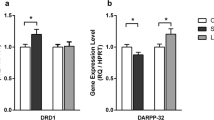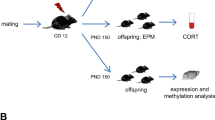Abstract
Separating rat pups from their mothers during the early stages of life is an animal model commonly used to study the development of psychiatric disorders such as anxiety and depression. The present study investigated how soon after the termination of the maternal separation period behavioural and neuroendocrine abnormalities relevant to above-mentioned illnesses would manifest. Sprague Dawley rat pups were subjected to maternal separation (3 h per day from postnatal day 2 through 14) and their behaviour and HPA axis activity determined 7 d later. We also measured nerve growth factor levels in their hippocampi and assessed the DNA methylation status of the promoter region of exon 17 of the glucocorticoid receptor in this brain region. As early as 7 d after the termination of the adverse event, a change in behaviour was observed that was associated with increased plasma corticosterone release and elevated nerve growth factor levels in the hippocampus. No alteration in the methylation status of the exon 17 glucocorticoid receptor promoter region was observed. Our data indicate that early life adversity may lead to the rapid development of abnormal behaviours and HPA axis dysregulation though no epigenetic changes to the exon 17 glucocorticoid receptor promoter region occurred. We further propose that the observed increased neurotrophin levels reflect compensatory mechanisms that attempt to combat the long-term deleterious effects of maternal separation.






Similar content being viewed by others
References
Anand KJ, Scalzo FM (2000) Can adverse neonatal experiences alter brain development and subsequent behavior? Biol Neonate 77(2):69–82
Boyle MP, Kolber BJ, Vogt SK, Wozniak DF, Muglia LJ (2006) Forebrain glucocorticoid receptors modulate anxiety-associated locomotor activation and adrenal responsiveness. J Neurosci 26:1971–1978
Daniels WM, Pietersen CY, Carstens ME, Stein DJ (2004a) Maternal separation in rats leads to anxiety-like behavior and a blunted ACTH response and altered neurotransmitter levels in response to a subsequent stressor. Metab Brain Dis 19:3–14
Daniels WMU, Richter L, Stein DJ (2004b) The effects of intra-amygdala CRF injections on rat behaviour and HPA axis function after stress. Metab Brain Dis 19(1/2):25–33
D’Arcangelo G, Halegoua S (1993) A branched signaling pathway for nerve growth factor is revealed by Src-, Ras-, and Raf-mediated gene inductions. Mol Cell Biol 13(6):3146–3155
Ecklund MB, Arborelius L (2006) Twice daily long maternal separations in Wistar rats decreases anxiety-like behaviour in females but does not affect males. Behav Brain Res 172:278–285
Enthoven L, de Kloet ER, Oitzl MS (2008) Differential development of stress system (re)activity at weaning dependent on time of disruption of maternal care. Brain Res 1217:62–69
Faure J, Uys JDK, Marais L, Stein DJ, Daniels WMU (2007) Early maternal separation alters the response to traumatization resulting in increased levels of hippocampal neurotrophic factors. Metab Brain Dis 22(2):183–195
Frommer M, McDonald LE, Millar DS, Collis CM, Watt F, Grigg GW, Molloy PL, Paul CL (1992) A genomic sequencing protocol that yields a positive display of 5-methylcytosine residues in individual DNA strands. Proc Natl Acad Sci 89:1827–1831
Heim C, Nemeroff CB (2001) The role of childhood trauma in the neurobiology of mood and anxiety disorders: preclinical and clinical studies. Biol Psychiatry 49:1023–1039
Honkaniemi J, Kononen J, Kainu T, Pyykönen I, Pelto-Huikko M (1994) Induction of multiple immediate early genes in rat hypothalamic paraventricular nucleus after stress. Mol Brain Res 25:234–241
Huot RL, Gonzalez ME, Ladd CO, Thrivikraman KV, Plotsky PM (2004) Foster litters prevent hypothalamic-pituitary-adrenal axis sensitization mediated by neonatal maternal separation. Psychoneuroendocrinol 29(2):279–289
Jaferi A, Bhatnagar S (2006) Corticosterone can act at the posterior paraventricular thalamus to inhibit hypothalamo-pituitary-adrenal activity in animals that habituate to repeated stress. Endocrin 147:4917–4930
Kalinichev M, Easterling KW, Plotsky PM, Holtzman SG (2002) Long-lasting changes in stress-induced corticosterone responses and anxiety-like behaviors as a consequence of neonatal maternal separation in Long-Evans rats. Pharmacol Biochem Behav 73(1):131–140
Kendall G, Ensor E, BrarRai A, Winter J, Latchman DS (1994) Nerve growth factor induces expression of immediate-early genes NGFIA (Egr-1) and NGFI-B (nur 77) in adult rat dorsal root ganglion neurons. Mol Brain Res 25:73–79
Kessler RC (1997) The effects of stressful life events on depression. Annu Rev Psychol 48:91–214
Ladd CO, Owens MJ, Nemeroff CB (1996) Persistent changes in corticotropin-releasing factor neuronal systems induced by maternal deprivation. Endocrinol 137:1212–1218
Ladd CO, Huot RL, Thrivikraman KV, Nemeroff CB, Meany MJ, Plotsky PM (2000) Long-term behavioural and neuroendocrine adaptations to adverse early experience. Prog Brain Res 122:81–103
Marais L, Van Rensburg SJ, Van Zyl JM, Stein DJ, Daniels WMU (2008) Maternal separation of rat pups increases the risk of developing depressive-like behavior after subsequent chronic stress by altering corticosteorne and neurotrophin levels in the hippocampus. Neurochem Res 61(1):106–112
Matsumoto T, Akiyama N, Kizaka-Kondoh S, Noda M (2000) Transient over-expression of NGF1-A gene suppresses NGF-induced neurite outgrowth in PC12 cells. Neuroreport 11(5):1001–1005
McEvoy C (2002) Characterisation of tumour associated HLA class I genetic and epigenetic gene alterations, PhD thesis, Flinders University of South Australia
Mohammed AH, Zhu SW, Darmopil S, Hjerling-Leffler J, Ernfors P, Winblad B, Diamond MC, Eriksson PS, Bogdanovic N (2002) Environmental enrichment and the brain. Prog Brain Res 138:109–133
Moser D, Molitor A, Kumsta R, Tatschner T, Riederer P, Meyer J (2007) The glucocorticoid receptor gene exon 1-F promoter is not methylated at the NGF1-A binding site in human hippocampus. World J Biol Psychiatry 8(4):262–268
Olsson T, Mohammed AH, Donaldson LF, Hendriksson BG, Seckl JR (1994) Glucocorticoid receptor and NGFl-A gene expression are induced in the hippocampus after environmental enrichment in adult rats. Brain Res Mol Brain Res 23:349–353
Plotsky PM, Meany MJ (1993) Early, postnatal experience alters hypothalamic corticotrophin-releasing factor (CRF) mRNA, median eminence CRF content and stress-induced release in adult rats. Mol Brain Res 18:195–200
Pryce CR, Feldon J (2003) Long-term neurobehavioral impact of the postnatal environment in rats: manipulations, effects, and mediating mechanisms. Neurosci Biobehav Rev 27:57–71
Rinne T, de Kloet ER, Wouters L, Goekoop JG, DeRijk RH, van den Brink W (2002) Hyperresponsiveness of the hypothalamic-pituitary-adrenal axis to combined dexamethasone/corticotropin-releasing hormone challenge in female borderline personality disorder subjects with a history of sustained childhood abuse. Biol Psychiatry 52(11):1102–1112
Rosen JB, Fanselow MS, Young SL, Sitcoske M, Maren S (1998) Immediate-early gene expression in the amygdala following footshock stress and contextual fear conditioning. Brain Res 796:132–142
Slotten HA, Kalinichev M, Hagen JJ, Marsden CA, Fona KC (2006) Long-lasting changes in behavioural and neuroendocrine indices in the rat following neonatal maternal separation: gender dependent effects. Brain Res 1097:123–132
Suomi SJ, Rasmussen KLR, Higley JD (1992) Primate models of behavioral and physiological change in adolescence. In: McAnarney K, Kreipe RE, Orr DP, Gormerci GD (eds) Textbook of adolescent medicine. Saunders, Philadelphia, pp 135–140
Szyf M, Weaver IC, Champagne FA, Diorio J, Meaney MJ (2005) Maternal programming of steroid receptor expression and phenotype through DNA methylation in the rat. Front Neuroendocrinol 26(3–4):139–162
Umemoto S, Kawai Y, Ueyama T, Senba E (1997) Chronic glucocorticoid administration as well as repeated stress affects the subsequent acute immobilization stress-induced expression of immediate early genes but not that of NGFI-A. Neuroscience 80:763–773
Uys JDK, Muller CF, Marais L, Harvey BH, Stein DJ, Daniels WMU (2006a) Early life trauma decreases glucoroticoid receptors in rat dentate gyrus upon restress: reversal by escitalopram. Neuroscience 137:619–625
Uys JDK, Marais L, Faure J, Prevoo D, Swart P, Mohammed AH, Stein DJ, Daniels WM (2006b) Developmental trauma is associated with behavioral hyperarousal, altered HPA axis activity, and decreased hippocampal neurotrophin expression in the adult rat. Ann NY Acad Sci 1071:542–546
Weaver IC, Diorio J, Seckl JR, Szyf M, Meaney MJ (2004) Early environmental regulation of hippocampal glucocorticoid receptor gene expression: characterization of intracellular mediators and potential genomic target sites. Ann NY Acad Sci 1024:182–212
Weaver IC, D’Alessio AC, Brown SE, Hellstrom IC, Dymov S, Sharma S, Szyf M, Meaney MJ (2007) The transcription factor nerve growth factor-inducible protein mediates epigenetic programming: altering epigenetic marks by immediate-early genes. J Neurosci 27:1756–1768
Yehuda R, Southwick SM, Krystal JH, Bremner D, Charney DS, Mason JW (1993) Enhanced suppression of cortisol following dexamethasone administration in posttraumatic stress disorder. Am J Psychiatry 150:83–86
Acknowledgements
This study was financially supported by grants from the National Institutes of Health (NIH) Fogarty International Center (R01TW008040), the Medical Research Council of South Africa, and the National Research Foundation of South Africa. The authors wish to thank Ms Susan Giegel for editorial services rendered.
Author information
Authors and Affiliations
Corresponding author
Rights and permissions
About this article
Cite this article
Daniels, W.M.U., Fairbairn, L.R., van Tilburg, G. et al. Maternal separation alters nerve growth factor and corticosterone levels but not the DNA methylation status of the exon 17 glucocorticoid receptor promoter region. Metab Brain Dis 24, 615–627 (2009). https://doi.org/10.1007/s11011-009-9163-4
Received:
Accepted:
Published:
Issue Date:
DOI: https://doi.org/10.1007/s11011-009-9163-4




